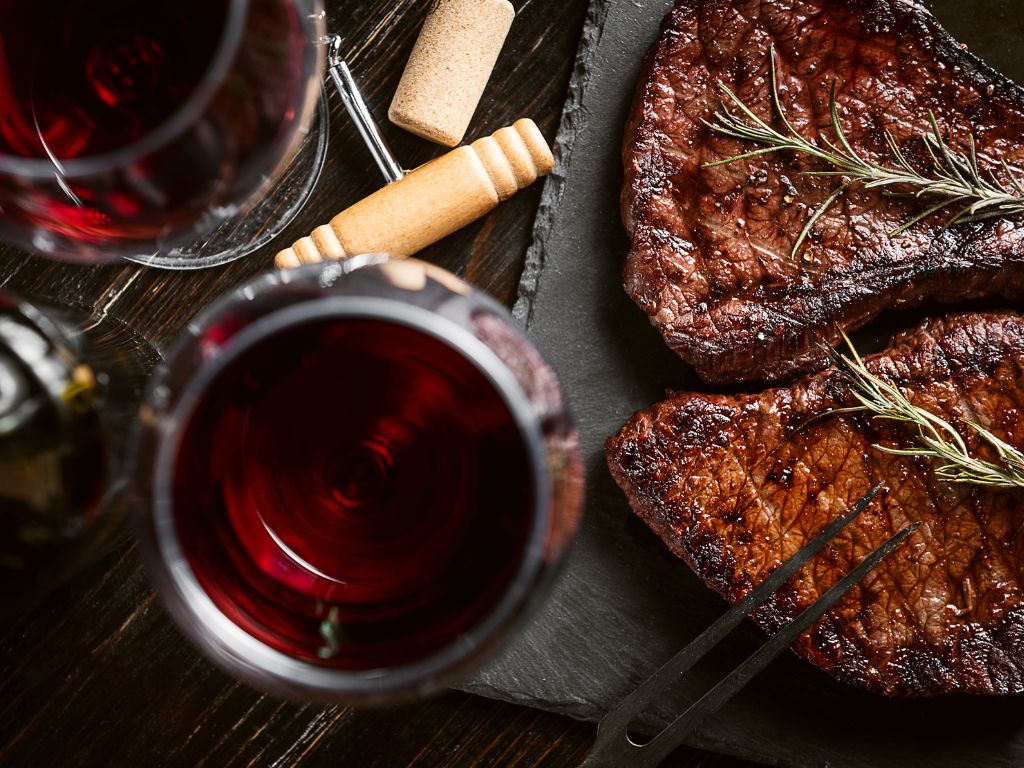
Did you know that Cabernet Sauvignon is the most widely planted red wine grape in the world? This beloved red wine is celebrated for its rich flavors and more. Known as the “King of Red Wines”, Cabernet Sauvignon captivates lovers with its strong character and versatility.
With over 850,000 acres dedicated to its cultivation, it’s no wonder wine enthusiasts can’t get enough of it. The mouth-watering experience of dark fruit flavors, coupled with hints of oak, makes every sip a delight.
If you’re intrigued by why this top wine has captured so many hearts, you’re in the right place! This article will tell you what you need to know about Cabernet Sauvignon and why it is a favorite among wine lovers everywhere.

What is Cabernet Sauvignon Wine?
The wine Cabernet wine is a Bordeaux blend with a rich history that dates back to the 17th century in France. Cabernet Sauvignon grapes are some of the most popular red wine grapes in the world.
The grape variety is a natural cross between Cabernet Franc and Sauvignon Blanc, hence the name “Cabernet Sauvignon.” Its alcohol content typically ranges between 13.5% and 15% ABV (alcohol by volume).
Cabernet Sauvignon is often used in blends, most famously as a key component of Bordeaux wines. In Bordeaux, it is typically blended with Merlot, Cabernet Franc, Petit Verdot, and sometimes Malbec.
Outside of Bordeaux, especially in New World wine regions like California and Australia, Cabernet Sauvignon is also frequently blended with varieties like Shiraz (Syrah) and Zinfandel.
Where does Cabernet Sauvignon come from?
Cabernet Sauvignon grapes originated in France, specifically in the wine-producing Bordeaux region. Like its blending partner Petit Verdot and some other wines, Cabernet Sauvignon became one of the most important grape varieties for red wine production there.
Cardinal Richelieu, a French clergyman, is credited with transporting vine cuttings from the Loire Valley to other parts of France. Eventually, it found its way to the New World, including Argentina with its cooler climates and high-altitude vineyards, where it thrived in wine regions like Mendoza.
Notable Cabernet Sauvignon wine regions include California’s Napa Valley. Here, it is known for its rich, full-bodied flavor and high-quality production. This region’s climate and soil create ideal conditions for cultivating this red wine grape, resulting in wines that are powerful, often with more than 14.5% ABV.
You’ll also find exceptional Cabernet Sauvignon from places like Chile, Tuscany in Italy, and South Australia’s Coonawarra regions.

Cabernet Sauvignon Taste
When it comes to taste, Cabernet Sauvignon is known for its assertive flavors.
You can expect to encounter notes of black currant, blackberry, and black cherry, often accompanied by hints of green bell pepper, mint, and eucalyptus.
- Black Currant: The dominant flavor, offering a rich and concentrated taste often described as cassis, with a touch of sweetness and a deep, dark berry essence.
- Black Cherry: Adds a juicy and slightly tart flavor, balancing the wine’s profile with a fruit-forward characteristic that enhances its complexity.
- Blackberry: The rich and intense blackberry flavors add a deep, fruity complexity to the wine, usually joined by subtle hints of dark plum.
As the wine ages, it develops rather interesting flavors like cedar, tobacco, leather, and vanilla.
The tannins from Cabernet Sauvignon grapes are typically strong, providing a firm structure and making the wine ideal for aging.
Often times, Cabernet Sauvignon is blended with other “Bordeaux Varietals”. At Aperture Cellars, their Cabernet Sauvignon is a prime example, with a vintage blend that incorporates Petit Verdot, Malbec, and a hint of Merlot, delivering intense black fruit flavors complemented by long, velvety tannins.

Cabernet Sauvignon Food Pairings
Pairing food with Cabernet Sauvignon is a delightful adventure because its bold flavors and high tannin content complement a wide range of dishes. These are a few of its ideal pairings:
- It’s a classic match for red meats like steak, lamb, and venison, because the high tannins help to cut through the richness of the meat.
- Cheeses, especially hard varieties like cheddar or gouda, also make great companions.
- If you’re in the mood for something savory, try pairing it with a hearty stew or a rich, tomato-based pasta dish.
- For a slightly unexpected pairing, dark chocolate can also work wonders, especially with an aged Cabernet Sauvignon.

Fun Facts
- Despite its widespread fame, the red wine grape was only identified as a cross between Cabernet Franc and Sauvignon Blanc through DNA profiling in the 1990s.
- Most Planted Wine Grape: Cabernet Sauvignon is the most planted wine grape in the world, covering approximately 850,000 acres globally.
- Sweet Cabernet Sauvignon exists. Some producers in regions like California create fruit-forward Cabernets that taste sweeter due to their rich, ripe fruit flavors.
When is Cabernet Sauvignon Day?
Cabernet Sauvignon Day is celebrated annually on the Thursday before Labor Day. It’s the perfect occasion to gather with friends, open a bottle (or two), and toast to the enduring legacy of Cabernet Sauvignon.
To be up-to-date on all the Wine Holidays, check out the Annual Wine Holiday Calendar.
Conclusion
Cabernet Sauvignon is a grape that has truly captured the hearts of wine lovers worldwide. The Bordeaux blend stands out as one of the most beloved red wines globally, known for its full flavors, aging potential, and food pairing versatility.
As you explore different regions and vintages, you’ll discover the unique characteristics that each brings to this single varietal.
Frequently Asked Questions
Is Cabernet Sauvignon Sweet?
Cabernet Sauvignon is typically a dry wine, meaning it contains very little residual sugar and does not taste sweet. However, the sweetness level can vary slightly based on the winemaking process and region.
Read more: Is Cabernet Sauvignon sweet?
Is Cabernet Sauvignon a red wine?
Yes, Cabernet Sauvignon is a red wine. It is one of the world’s most widely recognized red wine grape varieties, known for its deep ruby color and complex flavor profile.
Do you chill Cabernet Sauvignon wine?
Cabernet Sauvignon is best served at room temperature, around 55-65°F (15-18°C), to allow its complex flavors to shine. Avoid over-chilling, as it can mask the wine’s complex flavors.
Read more: How to chill wine fast
